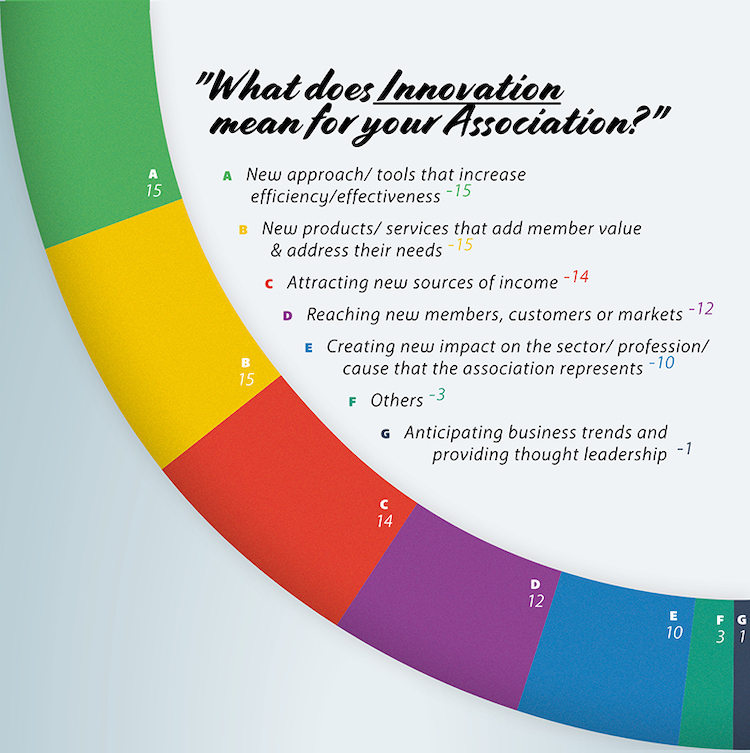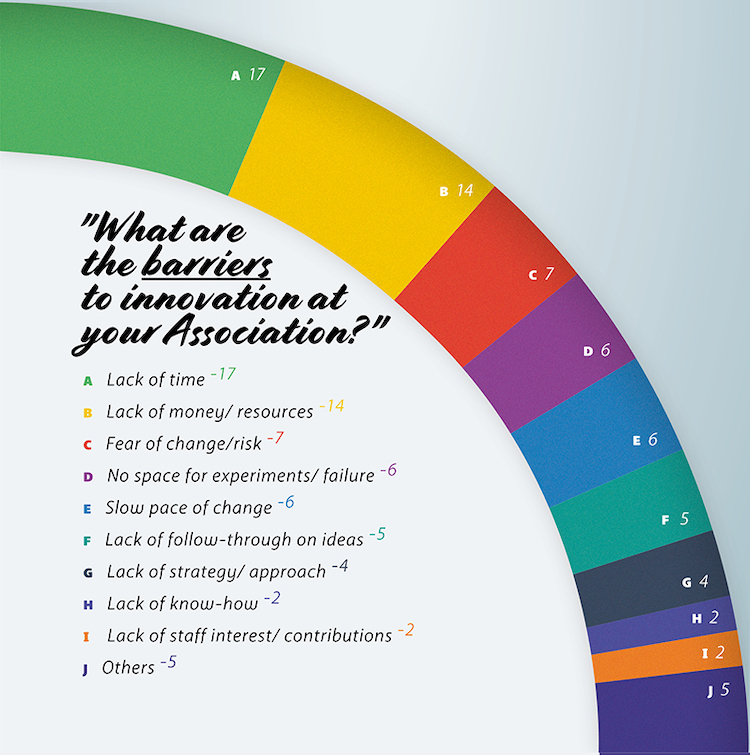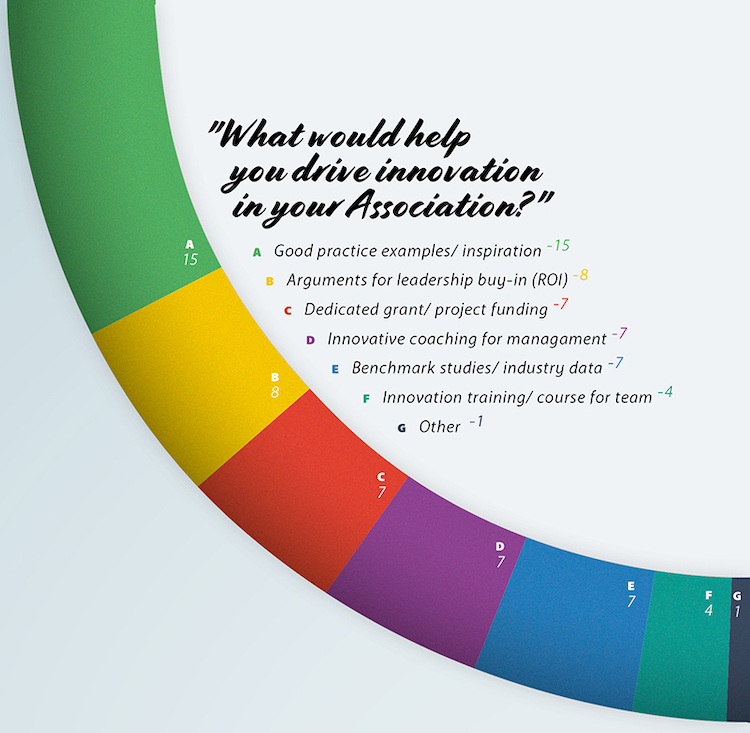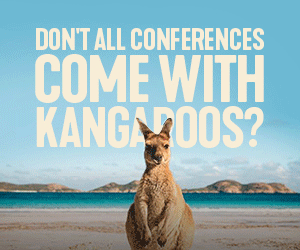It’s Now Time to Make a Change

Benita Lipps, Head of Association Management at Interel, tells us more about overcoming barriers to innovation at associations.
I am big fan of creative innovation, and have seen more than once how a little tweak at the right place can change an entire organisation for the better. After moving from science to association management, I naturally made it my mission to continue innovating in this new setting – and still remember the exact moment that I realised it just wouldn’t be all that straightforward…
It was during one of these rare face-to-face board meetings that most international associations can only afford to hold once or twice per year. Everyone was in the same room, on the same page and eager to find new solutions to long-standing challenges: how to become more relevant to members, how to ensure a solid financial basis, and how to run the association more efficiently without compromising on quality.
My team and I had invested much effort in preparation: analysing data, researching solutions, and discussing our suggestions with the relevant board members. This was a tried and tested approach.
So what could possibly go wrong?
No doubt some of you, deeply familiar with this kind of settings, are already chuckling at my naiveté and hubris: everything can go wrong! And it did: discussions focused on the minutia of implementation, it was pointed out that something similar had already been tried unsuccessfully in the past, doubts were raised if members would accept such drastic changes, or if these decisions should be taken at this point in time. Nothing was outright rejected and it was decided to revisit some of these ideas at a later, undetermined date.
So, what went wrong?
That’s when I realised: nothing went wrong. It’s just that associations are risk-averse by their very nature and design. Consequently, innovation and associations are hard to match. They are like fire and ice, like father and son the Cat Steven’s song:
It's not time to make a change,
Just relax, take it easy
You're still young, that's your fault,
There's so much you have to know…
Does that mean that there is no chance to innovate in an association?
That the time for change will never come? From my experience, the answer is absolutely not. It’s just that associations require a different approach to innovation and that the models that may work for tech start-ups, blue chip companies, or even NGOs won’t cut it in the association world.
The Quest for Association Innovation
This January, my team and I set out to test the following hypothesis: innovation is possible at associations, but it needs to follow a different path than in other sectors to be successful. In addition to talking to our client associations, we invited the international association community to share their experiences: To date, twenty-two were kind enough to respond, letting us know what innovation means for them, and what they consider the biggest challenges and opportunities.
What Is Association Innovation?
In order to figure out how to innovate in associations, it really helps to understand what innovation actually is. There’s just one little problem: innovation is one of the most overused words in business, education and marketing this decade. To quote Michael O’Bryan:
“Like Miss America contestants wanting world peace, the term ‘innovation’ has become the canned response of executives, politicians, and educators to the question, 'What do we need to be successful?’”
There are of course many insightful definitions - and anyone interested will be able to google those in a heartbeat. What I believe we are lacking though is not a notion what the word ‘innovation’ stands for, but what innovation means concretely for the everyday realities of associations.
When talking to diverse associations, three areas were mentioned regularly as the areas where associations need to – and can – innovate: increasing member value, efficiency in operations and improving financial stability.

What’s Stopping Us From Innovating?
Interestingly, achieving improvements in the three areas mentioned above may just be on the to-do list of every association professional out there. So, if the issues are that universally important, and if innovation is offering a way to tackle them, what is stopping us?
One obvious barrier to innovation is the one mentioned earlier: associations are risk-adverse by nature. Associations function as custodians, regulators or gatekeepers of a sector or profession. Safeguarding standards require continuity, care and consistency. Innovation, on the other hand, is deeply associated with risk, experimentation, and embracing disruptive change.
However, that’s not the only – or even the most obvious – challenge. In our discussion with association leaders, two other factors were mentioned repeatedly: First, there is lack of time. ‘Just’ keeping the association running, implementing a growing number of services and responding to the needs of members, partners, sponsors and leadership alike is stretching secretariats to the very limit of their capacity. “With a fast-growing association, we always play catch-up and need to invent as we go along. There is just not enough time for strategic thinking and effective brainstorming,” confirmed a contact at a global association who prefers to remain unnamed. Under these conditions, spending time to something as intangible as brainstorming, creative thinking and innovation are not only difficult, it can simply seem reckless.
Second, many associations state that they lack the resources to seriously ‘innovate’. This includes money, staff and – to a lesser extent – innovation know-how. Evidently, all of these are interconnected: “Funding, and therefore staff size is limited” notes one interview partner. “It is difficult to invest money in tools for experimentation only. The Board expects results, not experimentation,” writes another.
Innovation Is Dead; Long Live Innovation
Does that mean that association professionals should give up on innovation?
That we should focus on steering our ocean liners of continuity through the turbulences of progress and change, relying on the tradition and the ‘tried-and-tested’?
I don’t think we should, and all association leaders who participated in our study agreed.
Now, that we can frame the challenge – the fact that standard innovation models will simply not work for most associations – we can work towards new models. We can identify the innovation methods and tools that help associations deliver results for our members, our teams and our sustainability.
What could such an approach look like? Luckily, there’s no need to guess, just look around us. There are many association professionals out there innovating and are often happy to share their insights.
Less talk of innovation, more proactive problem-solving.
When most people think of innovation, they think of trendy tech people engaged in endless brainstorming, finding creative ideas and experimenting with beautifully designed prototypes. While there is nothing wrong with these approaches, innovation is essentially about finding useful solutions:
“An innovation is a feasible and relevant offering such as a product, service, process or experience with a viable business model that is perceived as new and is adopted by customers,”
Confirms Gijs van Wulfen, author of the FORTH Innovation Methodology. Let’s explain to our board, our teams and our partners that innovation is not blue-sky thinking, it is simply a smart tool for problem-solving.
While this may not sound as glamorous as ‘disruptive innovation’, experience shows that it’s often the little things that can make a big difference in the long run.

Not sure what that means?
Here are some concrete examples that were shared with us during our innovation research:
-
Tweaks to the statistical reporting helped to speed up delivery and to create bigger value for leadership
-
Renegotiating existing sponsor partnerships helped to create significantly more value for both the association and the sponsors
-
Running key governance and member meetings virtually helped save significant money on travel and allowing for more agile working and collaboration.
When lack of time and resources are ‘the’ key barriers to innovation, and when a need for more innovation has been identified as essential by the very same association, the solution seems easy: it is time to invest in innovation: by hiring more staff or by investing in new solutions.
From our discussions, we learned that some associations have come to the same conclusion and started acting on it:
-
One society has just strengthened and grown their internal conference organising team, allowing them to offer more value and better service to their participants
-
Another European alliance is hiring an additional staff member as communication and projects officer.
-
Four associations invested in technology. Two developed their extranet, offering members better services without increasing staff time. Two others invested in member management and invoicing tools, allowing them to automate some administrative work.
However, to the majority of associations, the option of this kind of ‘hard’ investment is simply not available. Tight budgets or a frugal leadership make it unlikely that any new resources can be dedicated to innovation anytime soon.
What can be done? It’s time to get innovative with innovation. But how?
Let me share some examples:
Creating innovation partnerships can be a great way to create innovative impact without spending any hard cash: One association reported that they partnered with one of their members which is working on a large-scale initiative with the potential to become global. Without interfering in the implementation work, they agreed a 'win-win' deal whereby the member involves the international association, in exchange for support in promoting and communicating the initiative. Two other associations have created industry partnerships to offer exclusive access to knowledge and resources to their members.
Last but not least, here’s my favourite no-cost innovation tip – one that has probably generated the most positive impact in my work with innovation in the last ten+ years:
Empower your staff to become a team of problem solvers.
Touted as ‘fostering an innovation mindset’ in the relevant literature, it’s really nothing more than encouraging all team members to keep their eyes open for problems and to discuss these openly. It’s essential to make it clear that this is not done in order to assign blame or to highlight failures – on the contrary. Identifying a problem is the first step to finding a solution, and this is best done together, as a team.
In addition to promoting innovation, it also has a very welcoming side effect: it empowers people in their jobs. None of the talented, dedicated and multifaceted experts working for associations want to be treated as mindless executors, they want to make a difference with their work.
In short, invite your team to be curious, honest, supportive and to take full responsibility for their work. Lead by example. And – voila – your innovation task force is born.

What’s Next?
Almost 70% of the association leaders interviewed believe that innovation will become more, or much more important over the next two years. The same percentage is in need of good practice examples that can inspire them on their path to innovation.
This seems the right time to share experiences, understand common challenges and define good practice and hopefully, this article and its underlying research are a step in the right direction. Others seem to agree and I am deeply grateful to the 22 associations – including AIB, ASAE, BioMed Alliance, CSC, EFFA, ESAE, FAIB, FEA, FICAC, ICAS and the Royal College of Physicians – that contributed to this conversation and shared their stories. It’s equally inspiring that HQ Magazine, ESAE and the Visit Brussels Association Bureau have considered this topic of enough importance to support the Association Innovation 2019 Initiative through their own channels.
Join the Association Innovation LinkedIn Group http://bit.ly/AssociationInnovation to get access to more results of this research and to add your voice to the growing body of stories and evidence. With everyone’s help, we aim to publish the final results as an open white paper ‘Association Innovation 2019’ and – if there is any interest – to discuss the findings in one of our Association Intelligence Sessions. Should you wish to be kept updated on either, join the Association Innovation LinkedIn Group or get in touch with me directly.
Let’s move towards meaningful association innovation in 2019 together. Now is the time to make a change.
Other Articles
About Us
Supported by the Union of International Associations (UIA), the International Association of Professional Congress Organisers (IAPCO) and the Interel Group, the global public affairs and association management consultancy, Headquarters Magazines serve the needs of international associations organising worldwide congresses.















